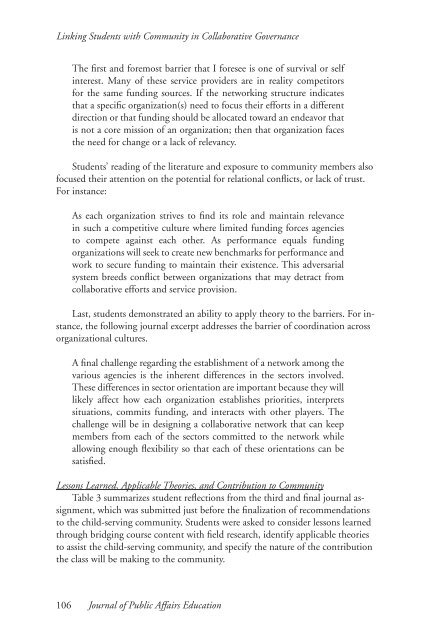Journal of Public Affairs Education
Create successful ePaper yourself
Turn your PDF publications into a flip-book with our unique Google optimized e-Paper software.
Linking Students with Community in Collaborative Governance<br />
The first and foremost barrier that I foresee is one <strong>of</strong> survival or self<br />
interest. Many <strong>of</strong> these service providers are in reality competitors<br />
for the same funding sources. If the networking structure indicates<br />
that a specific organization(s) need to focus their efforts in a different<br />
direction or that funding should be allocated toward an endeavor that<br />
is not a core mission <strong>of</strong> an organization; then that organization faces<br />
the need for change or a lack <strong>of</strong> relevancy.<br />
Students’ reading <strong>of</strong> the literature and exposure to community members also<br />
focused their attention on the potential for relational conflicts, or lack <strong>of</strong> trust.<br />
For instance:<br />
As each organization strives to find its role and maintain relevance<br />
in such a competitive culture where limited funding forces agencies<br />
to compete against each other. As performance equals funding<br />
organizations will seek to create new benchmarks for performance and<br />
work to secure funding to maintain their existence. This adversarial<br />
system breeds conflict between organizations that may detract from<br />
collaborative efforts and service provision.<br />
Last, students demonstrated an ability to apply theory to the barriers. For instance,<br />
the following journal excerpt addresses the barrier <strong>of</strong> coordination across<br />
organizational cultures.<br />
A final challenge regarding the establishment <strong>of</strong> a network among the<br />
various agencies is the inherent differences in the sectors involved.<br />
These differences in sector orientation are important because they will<br />
likely affect how each organization establishes priorities, interprets<br />
situations, commits funding, and interacts with other players. The<br />
challenge will be in designing a collaborative network that can keep<br />
members from each <strong>of</strong> the sectors committed to the network while<br />
allowing enough flexibility so that each <strong>of</strong> these orientations can be<br />
satisfied.<br />
Lessons Learned, Applicable Theories, and Contribution to Community<br />
Table 3 summarizes student reflections from the third and final journal assignment,<br />
which was submitted just before the finalization <strong>of</strong> recommendations<br />
to the child-serving community. Students were asked to consider lessons learned<br />
through bridging course content with field research, identify applicable theories<br />
to assist the child-serving community, and specify the nature <strong>of</strong> the contribution<br />
the class will be making to the community.<br />
106 <strong>Journal</strong> <strong>of</strong> <strong>Public</strong> <strong>Affairs</strong> <strong>Education</strong>



